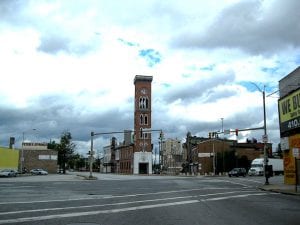
Baltimore, Maryland. Photo by Doug Kerr, via flickr, CC BY-SA 2.0
It is hardly a coincidence that these four books, all of which look at the challenges facing America’s small cities and towns, have appeared more or less simultaneously during the past year. While they were all in the works before the 2016 presidential election, the increasing visibility of the opioid epidemic, followed by Trump’s victory, which was secured by his unexpected success in a handful of Rustbelt states, have made a lot of people sit up and take notice of places that were previously largely off the media radar. We now have these books, which not only offer something of a window on what is—or is not—going on in these places, but may also offer some useful pointers for practitioners, particularly but not exclusively those working in the types of place the authors describe.
What do we mean, though, by small cities, and what are their challenges? There are hundreds of small cities in the United States, places between, say, 25,000 and 100,000 or 150,000 people. While they run the social and economic gamut from rich to poor, from thriving to moribund, many are struggling, particularly places like Trenton, New Jersey or Youngstown, Ohio which were once bustling manufacturing centers, but are still trying today to figure out how to cope with the blows of deindustrialization, out-migration and the still-lasting effects of the Great Recession.
Some are real cities, with tall downtown buildings, state universities and hospitals, while others are really overgrown small towns. In contrast to the much-heralded success stories coming out of larger cities like Pittsburgh or Baltimore, few have seen sustained revival. Numbering in the hundreds, those places form an archipelago of mingled revival and distress which – although most heavily concentrated in the industrial Midwest – stretches from coast to coast.
But these cities are not an undifferentiated collection of interchangeable urban parts. Each one has its own character and history, its civic culture, and its own collection of human beings working to make their community a better place. At the same time, these cities are not free agents; they are intensely vulnerable to the forces of change operating at the national and global levels, from the inexorable pressures of demographic and social change to decisions made in Washington, Wall Street, or the corporate boardrooms of (the metaphorical) Detroit.
All of this makes the story of America’s small cities a difficult one to write about. The ideal book should not only capture the distinctive flavor and human reality of the place or places it describes, but should also show how that reality fits into the larger picture of our economic and political life today, help the reader understand the underlying forces that have all but undone these cities’ proud industrial heritage, and finally, provide some critical perspective on what is being done or can be done to reinvent, as it were, these cities for the twenty-first century. That is a tall order.
Predictably, no one book captures everything. In many respects, though, the two books that each tell the story of a single place come closest, although neither offers much in the way of suggestions about what can be done moving forward. Brian Alexander, who depicts the gradual unravelling of Lancaster, Ohio; and Amy Goldstein, who portrays what happened in Janesville, Wisconsin after the GM plant closed, both vividly describe the change in these two cities by following the fortunes of a small band of people and families who become, to the reader, the voice of their community over time. Alexander, though—who grew up in Lancaster—gives the reader a far more visceral feeling for the place and its people than does Goldstein, a gifted Washington Post reporter who remains, despite her efforts, an outsider.
Both authors tell their story well, but Alexander also gets what lies behind Lancaster’s decline and the evisceration of the town’s flagship manufacturer, iconic glassmaker Anchor Hocking. While the story of the predatory lenders that victimized millions of homeowners and home buyers with subprime mortgages in the late 1990s and early 2000s, sending neighborhoods across the United States into a tailspin from which many have never recovered, is well known, far fewer people are aware of the similar practices that played a crucial part in the gutting of American industry during the same period.
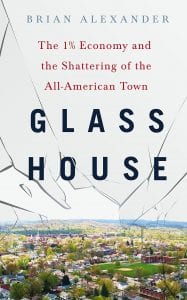
There’s no question that some of those jobs would have been lost under any likely scenario. Some factories were obsolete and unproductive, some were off-shored, and in others, changing manufacturing processes meant that fewer workers were needed to make the same amount of stuff. But few people have shown how the process worked by which Wall Street firms, variously known as corporate raiders, venture capitalists, private equity funds, or leveraged buyout specialists, systematically turned company after company into piggybanks, milking them for unconscionable fees while loading them with ever-larger amounts of debt, collecting the profits while saddling the companies with unsustainable repayment burdens, ultimately destroying firms that without those burdens would have still been able to make a competitive product at a reasonable profit.
This story shares uncanny parallels with the subprime mortgage story, about how predatory capitalism untethered by effective regulation systematically undermined not only our neighborhoods, but our livelihoods and the communities that depended on them. I’m not suggesting that this was the only factor in the collapse of manufacturing in the 1990s and 2000s, but its contribution, if that’s the right word, needs to be better understood.
This is the story that Alexander gets, brilliantly dissecting how Anchor Hocking became the victim of the predatory capital game, passed like a hot potato from one investor to another, its various parts spun off and increasingly loaded with debt. Once the city’s mainstay employer, it still exists after going through two rounds of bankruptcy, but as a shadow of its former self, employing only 900 or so people instead of the 5,000 who once worked there.
Both Alexander and Goldstein capture another important part of their cities’ story, which, as with the role of predatory capital, is not always appreciated, but is even more fundamental to understanding what is going on in these cities, as well as in American society more broadly, today.
Both authors follow something of a cross-section of each city’s society: bank managers, corporate executives, social service providers, struggling factory workers, and, for Alexander, sensitively portrayed drifters and strung-out drug users. As time passes, one sees not only how different the lives of the executives and managers are from the others, but how, as the factories close and the union locals disintegrate, the initial gap between the two groups widens into a chasm, as even the way each group looks at the same community becomes radically different.
Losing factories in a place like Janesville or Lancaster was about far more than losing well-paying blue collar jobs. The factories were about identity, about solidarity, and about a social contract. Those jobs meant that factory workers were part of the middle class, that their kids could go to college, and that they had a stake in the community as real as that of the president of the local bank. In Lancaster, when Anchor Hocking was locally-owned, it was even more than that, as line workers and managers bent elbows in the same downtown taverns, and workers’ sons would go off to college and come back home to become managers. All that disappeared.
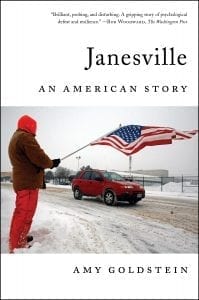
Yes, in some respects Janesville’s economy has revived. Unemployment is low – mostly thanks to local workers commuting to jobs all over southern Wisconsin and northern Illinois – and Dollar General has opened a distribution center just out of town. But the social contract has been broken, and it’s not clear whether the people who gathered at the Holiday Inn Express to listen to Paul Ryan even understand that, let alone have any ideas about how to fix it. Indeed, as Americans increasingly retreat into their tribes, it seems they not only have difficulty hearing one another but even in remembering that there’s someone other than themselves out there.
When one turns from these two books to the one by James and Deborah Fallows, the reader enters a different, sunnier world. The authors want to change the national conversation; as James Fallows (the book is written in alternating sections by the two authors) writes, “despite the economic crises of the preceding decade and the social tensions of which every American is aware, most parts of the United States have been doing better, in most ways, than most Americans realize.” In the course of their travels, the Fallows touch down in a lot of different places. These places come in many shapes and sizes, but a lot of them, like Erie and Allentown, Pennsylvania, or Duluth, Minnesota, fall squarely into the small city basket.
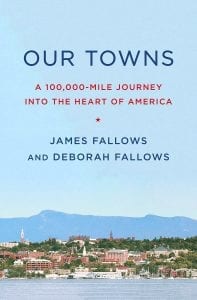
At the same time, the Fallows share the tunnel vision of their tribe, the tribe of highly mobile, well-educated professionals with sophisticated tastes. They are a thoughtful and concerned pair, to be sure, but still very much products of their tribe. As such, they gravitate time after time to the tribal symbols of revival and success: riverwalks, art galleries, bike paths and brewpubs. James Fallows writes, “a city on the way back will have at least one craft brewery, maybe more, and probably some small distilleries, too.” Perhaps, but on the way back for whom, though?
That is a little unfair to the Fallows. They do spend quite a bit of time visiting schools and community colleges, and talking to people about immigrant integration, and they recognize the importance of all three to the future of the cities and towns they visit. The sections where they talk about these issues, how Dodge City’s schools are helping to integrate the city’s Latino immigrants, or how the Kepler Neighborhood School in Fresno connects its children to the community – and the community to them – are the book’s best pages. At the same time, although many people in many of the cities the Fallows visited share the despair and frustration of their counterparts in Lancaster and Janesville, you would never be able to tell that from this book. It may have something to do with spending so much time in craft breweries.
After three books that described things, I turned to Quint Studer’s book with some hopes and expectations. Finally, I thought, a nuts & bolts book that actually tells one how to do it. If only it were true. Quint Studer is by all accounts an admirable individual, a multimillionaire health care executive who decided about 15 years ago to spend a lot of his energy and a lot of his money revitalizing the downtown of Pensacola, his adopted Florida panhandle community. Despite the title, though, his book turns out not to be about reshaping America, or even about reshaping Pensacola, but about reshaping downtown Pensacola. As such, it offers some insights into how his efforts helped realize the potential of the city’s downtown, including some good down-home ideas about where to start and about getting people to work together, but little more.
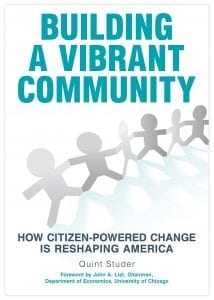
I’m not suggesting that affordable housing developers and CDCs necessarily should drop everything they’re doing and focus on improving their local schools (although in some cases, that might not be a bad idea), but I would argue that any affordable housing developer or CDC who is not at some level engaged in supporting better schools, or more effective workforce development, for the children and adults of the communities where they work, is shortchanging their community.
In the final analysis, the plight of America’s small once-industrial cities is a daunting one. While some, like Lowell, Massachusetts, Lancaster, Pennsylvania or, for that matter, Pensacola, Florida can build on their proximity to big cities like Boston or regional assets like Amish country or Florida beaches, many lack that luxury. Neither Lancaster nor Janesville has found the way out, and despite the Fallows’ implicit prescription, copying the big-city brewpub and bike path playbook and building the amenities that will attract Richard Florida’s Creative Class doesn’t get you that far when the underlying economic engines—particularly the big research universities and medical centers—aren’t there. In the end, I’m not sure there is always an answer.
Glass House: The 1% Economy and the Shattering of the All-American Town, by Brian Alexander. Macmillan, 2017, 336 pp., $26.99 hardcover.
Janesville: An American Story, by Amy Goldstein. Simon and Schuster, 2018, 368 pp., $16.00 softcover.
Our Towns: A 100,000 Mile Journey into the Heart of America, by James Fallows and Deborah Fallows. Pantheon, 2018, 432 pp., $28.99 hardcover.
Building a Vibrant Community: How Citizen-Powered Change is Reshaping America, by Quint Studer. Be The Bulb Publishing, 2018, $24.95 softcover.

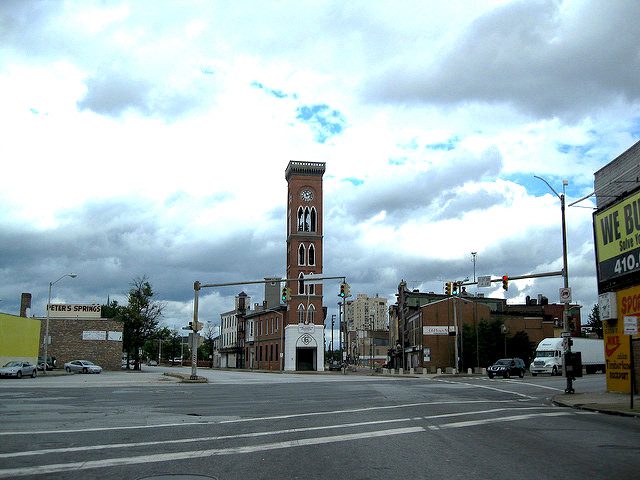




Comments